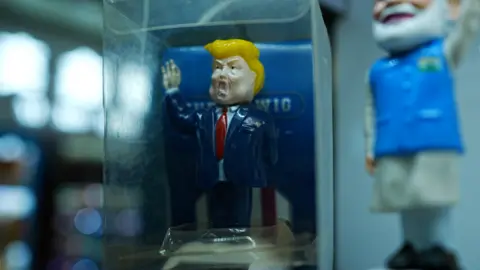
"We don't care about sales to the United States," says Hu Tianqiang as one of his toy fighter jets flies past our heads.
It's hard to hear him above the buzzing toy planes and miniature drones, an almost rhythmic backdrop to the cacophony of toys that surround him, all clamouring for the attention of buyers.
Hu's stall, Zhongxiang Toys, sits inside the world's biggest wholesale market in the small Chinese city of Yiwu.
It's a huge showroom of more than 75,000 shops where buyers come seeking just about everything, from twinkling Christmas lights and kitchenware to umbrellas and massage guns. It can take most of the day just to get around one department given each of them has an airport hangar's worth of goods on show.
Yiwu is in the province of Zhejiang, along China's eastern coast. The manufacturing and export hub, home to more than 30 ports, accounted for 17% of all Chinese sales to the US last year.
That puts Yiwu, and this region, at the frontline of the US-China trade war.
Mr Hu, too, is on the frontline. He sits among rows of snazzy toy jets, squeaking dogs, fluffy stuffed animals, barbies and motorcycle-riding spidermen – a sliver of the $34bn (£25bn) worth of toys China exported in 2024.
About $10bn of it went to the US. But now, these Chinese exports to America face up to 245% tariffs. And US President Donald Trump has made it clear that he blames Beijing in particular for cornering too much of the global market.
But things have changed here since Trump's first trade war against China, which kicked off in 2018. It taught Yiwu a lesson, summed up by Mr Hu: "Other countries have money too!"
That defiance has become a familiar theme in the world's second-biggest economy, which is bracing itself for another turbulent Trump presidency.
Beijing, which has been repeatedly telling the world that the US was bullying countries into trade negotiations, has not backed down yet from the trade war.
The propaganda online has ratcheted up, applauding Chinese innovation and diplomacy in contrast to the uncertainty unleashed by Trump. On the country's highly controlled social media, there are plenty of posts echoing the leadership's promise that China will keep fighting.
And in factories and markets, businessmen and exporters now say they have other alternatives, beyond Trump's America. Mr Hu, for instance, says around 20%-30% of his business came from US buyers. But not anymore.
 BBC/ Xiqing Wang
BBC/ Xiqing Wang BBC/ Xiqing Wang
BBC/ Xiqing Wang"We don't care about that 20-30%," Mr Hu says. "We now sell mostly to South America and the Middle East. We are not lacking money, we are rich."
When we ask about Trump, his colleague Chen Lang jumps in, rolling his eyes: "He's cracking international jokes like no other. One day, one joke. Adding tariffs for him is like cracking a joke."
Nearby, one of the thousands of buyers that flock to this market every day is negotiating a price to buy more than 100 robots that turn into cars in a series of beeps and buzzes. After tapping various numbers into a calculator, the final price is written in chalk on the floor.
The buyer, we are told, is from Dubai. The BBC met many others from across Africa and South America.
Lin Xiupeng says he has noticed the shift away from American buyers in his last 10 years in the toy business.
"A few days ago, the shop next to us had an order from a US client. It's worth more than one million yuan. But because of tariffs, the shop owner decided to cancel it," he says, offering us cups of tea.
"They must need China," he says, adding that the country supplies most of America's toys.
"I think there are a lot of businesses in the US protesting these days."
 BBC/ Xiqing Wang
BBC/ Xiqing WangMr Lin is correct. Some toy shop owners in the US have written to the White House describing the tariffs as "disastrous" for their business.
"The tariffs are taking a hatchet to small businesses across America," Jonathan Cathey, who owns a toy company in Los Angeles, told the BBC over the phone.
He invested his last $500 in his company, Loyal Subjects, in 2009, which he ran from his two-bedroom bungalow in West Hollywood. He says it's now a multi-million-dollar business, but the tariffs could derail his plans.
"The entire toy industry could go under. We are looking at the total implosion of the supply chain. It's going to get really ugly," he warns.
He says swapping suppliers is a huge task: "You need a lot of resources on the ground to produce a toy and many of these Chinese businesses have spent 40 years perfecting their craft."
China has been a big part of Donald Trump's first 100 days in office, with his administration going head-to-head with Beijing.
"He seems to be launching a crusade against the whole world," says former Senior Colonel Zhou Bo, who served in the People's Liberation Army. "But of course he's trying to bash China the hardest."
Trump accused China of operating the Panama Canal, which is run by a Hong Kong-based firm, and vowed to take it back. He has been on the hunt for ways to mine rare earth minerals, which China effectively has a monopoly over, making this a key part of any deal with Ukraine. His threats to take Greenland are also likely aimed at curbing China's ambitions in the Arctic.
And, of course, he initiated another trade war, which takes special aim at China's neighbours, such as Vietnam and Cambodia, that have been crucial to its evolving supply chain.
 BBC/ Xiqing Wang
BBC/ Xiqing WangIn the last week, he suggested the levies on Chinese goods could be halved and spoke of "a fair deal with China" that his administration was "actively" negotiating.
But China's Commerce Ministry rebuffed this as "groundless with no factual basis". The headlines in state media haven't spared him either: "Trump is probably the worst president in American history," read one on state TV.
It seems the US president is waiting for his Chinese counterpart Xi Jinping to pick up the phone.
"We in China say – we have to let the bullet fly for a moment," Col Zhou says. "That means in the fog of war, we do not know what will come next. I believe this kind of tit-for-tat would last for maybe one or two months – hopefully not more than three months."
It cannot go on, he adds, because that would not be good.
It's certainly not good for China. Trump's tariffs are not even the biggest challenge facing the country, which is also grappling with domestic economic pain, from low consumption to a housing crisis that has dented people's savings and confidence in the future.
The terrible timing aside, the tariffs are biting Chinese businesses.
Goldman Sachs has forecast that China's economy will grow by 4.5% this year, short of the government's target: 5%.
The BBC reported from the trading hub of Guangzhou in mid-April that US-China trade was grinding to a halt, with exports to American households piling up on factory floors. That is borne out by this month's economic data, which show that activity in factories has sharply slowed.
 BBC/ Xiqing Wang
BBC/ Xiqing WangWhen the BBC rang suppliers to see if shipments to the US had resumed, what emerged was a messy picture. One supplier said he had half-a-million pieces of clothing waiting to ship to Walmart, and a few others echoed his uncertainty. But two exporters we spoke to said some shipments from US retailers had indeed restarted.
The range and complexity of the trade between the two economies, which includes cargo cranes, umbrellas and everything in between, means that it's often down to different businesses and supply chains as to how they deal with the tariffs.
But whatever the business, there is no doubt the American consumer will feel the absence, or potentially higher prices, of Chinese goods.
The US still relies heavily on Chinese manufacturing to meet its own domestic demand – think phones, computers, semiconductors, furniture, clothes and, of course, toys. Electronics and machinery alone account for more than 50% of US imports.
Walmart and Target reportedly told Mr Trump in a meeting last week that shoppers are likely to see empty shelves and higher prices from next month. They also warned that supply shocks could carry on until Christmas.
Some 90% of all Christmas decorations hung around American homes come from Yiwu in China where sellers, surrounded by signs wishing the world "Feliz Navidad" told us they're now trying to focus on sales to South America.
And that effort is very evident in Yiwu.
In the early morning, before the shutters even open, the cavernous lobby of the wholesale market echoes with voices reciting key phrases.
"Shukran," says the teacher in Arabic. The students repeat it several times to perfect the pronunciation before learning that it means "thank you". "Aafwan" comes the reply, or "you're welcome".
 BBC/ Xiqing Wang
BBC/ Xiqing WangThese are free lessons offered by a local government association. Most of the students are women, dressed in their best to also impress their customers.
"These women are the backbone of trade across China," says one stall holder, who originally from Iran and is giving private lessons to an eager student.
"They're doing these lessons to stay ahead of one another, to stay in competition."
Most of the traders can already speak a few words of English. but now they say they need to greet their new buyers in Spanish and Arabic – a small but crucial sign of China's shifting trade relationships.
Oscar, a Columbian who would only give us his first name, was wandering the halls of the market with bags filled with fluffy bunnies and bears.
He says the US-China trade war offers "many opportunities" for traders from other parts of the world.
"Doing business with China is very important," he insists. "[Doing business with] the US these days, less so."